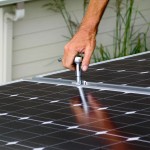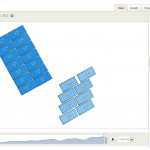 Solar Powered Ham Shack
Solar Powered Ham Shack
Finally everything fell in place… my shack is running on solar power only. An idea/project I have been pursuing for years but the circumstances were never perfect… until this July. Last fall, a hailstorm took care of the roof and I had to replace it. In July I was able to secure a large chunk of money from our City which is offering a (very) limited number of rebates for Photovoltaic (PV) installations. Together with the federal tax credits it will put the ROI within my life expectancy. Good enough for me.
The complete system is a grid tied, 5.5 kW system – 22 panels organized in two arrays (one south and one west facing). Each panel has a microinverter to optimize production and to add some ‘intelligence’ to the system. Monitoring and trouble shooting is a breeze. I can literally see when a bird poops on a panel and degrades my production 🙂
Since my shack consists only of a Yaesu FT-817, I am using the excess energy in the rest of the house. It should produce over 100% of our typical electricity usage per year if everything goes according to plan – I guess time will tell.
Here a short clip of the installation:
Please add your questions and comments through Youtube.















When you said “Microinverter” I cringed. I recently visited the QTH of a local ham who had a very similar system.
Unfortunately, the reason for my visit was to determine what, if anything could be done to reduce the low-level melange of hiss and spurious emissions that blanketed all HF and VHF frequencies with each panel’s microinverter being its own emitter.
It appeared that relatively little of the energy was being emitted along the AC power cable, but mostly from the face of the panel indicating that were filtering to be installed, it would have to be done on the DC (input) side of things. It was also noted that the QRM got worse as the frequency went up and that on VHF, low-level spurs could be detected at least a half a block away. The consolation was that at night, at least, the roar quieted down and the bands became useful: Disconnecting the AC mains didn’t help much during the day, but it did kill the last of the spurs that were still audible once the panels were dark.
The recommendation that I left him with was to relocate the HF antenna as far away as possible from the panels (which was only about 10-15 feet farther away due to limited space) and this did, at least, knocking down the QRM on HF receive a bit.
I suppose that it might have been possible to install DC-side filtering, but this may have voided any warantees since no manufacturer-made filters were available and it would have required a mechanical re-installation of the entire system since the backs of the panels were inaccessible, anyway.
Hopefully your system is much quieter!
I’m assuming the multiple ‘micro’ inverters were largely suggested because you have two panel array locations?
If the panels were in one large array, and only one inverter were used, is the overall efficiency likely to be about the same? (I’m thinking one inverter could be less noisy!?)
Obviously, the attractiveness of a SPV system could become a large disappointment to a ham whose station was compromised!
Any other stories out the guys?
Greg
K7YDL
(Looking at a similar 5 KW system here in Oregon)
Greg, I could have used ‘normal’ string inverters even with the two arrays pointing in different directions. However, after researching the Microinverters I came to the conclusion that they are indeed more efficient. Solar panels have typically a +/- 5% tolerance. A regular string inverter has to adjust to the weakest link in the string. That means you can easily loose 5% or more of your generated output in an array, every day for the next 25+ years. In my case, each panel has a Microinverter with a MPPT controller and is just optimizing for this one panel, not a whole string. There is also the thought of single-point of failure. Your string inverter goes down, you are not producing any power at all. If a Microinverter goes down, I am loosing very little. If you have shading issues on your property, Microinverters are the way to go since they optimize on panel level and not on a string level. Depending on the amount of panels you are installing, Microcoinverters are initially more expensive. A string inverter needs to be replaced after ~15 years ($$$). My system has a 25 yr warranty (panels and Microinverters) . Will the company still be in business in 20 years…. I don’t know but I sure hope so. Those were some of my thoughts making the decision. Now back the the noise…. I am not sure whether Clint’s story applies to me… I always had a very noisy environment. All I can say is that i had S8 noise on 20m before and S8 noise on 20m after the installation. But it’s certainly a valid point for a ham. If you would like more details, feel free to contact me offline.
Matt/KØMOS
I have to admit i always had been a liltte leary of all hype happening around solar. After looking at several programs and buy options we chose to take the plunge. We wound up getting solar without having money down and now we immediatly started saving money the very first month is was installed. I have to admit that this benefits associated with solar are real and I am very happy we chose to proceed with it.